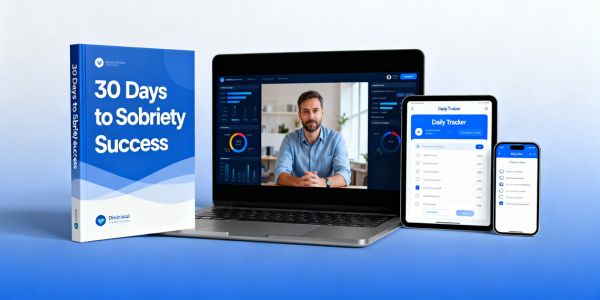Recover Without Rehab: The Medical Protocol for Functional Alcohol Use Disorder.
You don’t need 30 days away. You need a medical tapering strategy and a dopamine reset. 100% Private. 100% Online.
For high-performing individuals, the biggest barrier to recovery isn’t the addiction itself - it’s the logistics. You cannot afford to pause your career, alert your colleagues, or vanish for 30 days. But ‘white-knuckling’ it alone is dangerous and ineffective.
We bridge this gap. The Liverehab Sobriety Success Method brings the clinical structure of an inpatient facility directly to your privacy. It allows you to treat Alcohol Use Disorder (AUD) with medical precision, on your own schedule, and without a permanent record.
Can I detox from alcohol at home safely?
Yes, home detox is safe for mild-to-moderate Alcohol Use Disorder (AUD) if you are not at risk for severe withdrawal symptoms like Delirium Tremens (DTs) . A safe home protocol requires a structured tapering schedule (reducing intake by 10% daily) or medication-assisted treatment (MAT) under remote supervision.

Our Alcohol Freedom Course includes the ‘Safety Taper’ calculator to manage this reduction precisely.

What is a ‘Functional’ Alcoholic? (Gray Area Drinking)
A functional drinker (or “Gray Area Drinker”) maintains professional success and family stability while dependent on alcohol for chemical regulation . You may not hit “rock bottom,” but you experience micro-withdrawals, anxiety spikes at 4 PM, and sleep fragmentation that degrades executive function over time.
You don’t need to hit rock bottom to stop. Use our Executive Reset Module to quit while you are still ahead.
How long does alcohol withdrawal last?
Acute physical withdrawal typically peaks at 72 hours and subsides by day 5-7. However, Post-Acute Withdrawal Syndrome (PAWS)—characterized by anxiety and brain fog—can last for 6-24 months without cognitive behavioral intervention

The 90-Day Brain Repair roadmap in our course prevents PAWS by actively restoring dopamine baseline.
The 4-Phase Functional Recovery System
Recovery is not about willpower; it is about biology. This protocol is not a collection of random videos, but a structured clinical intervention designed to dismantle addiction at the neurological level. Over four distinct phases, we move you systematically from physical stabilization to psychological reconstruction, giving you the exact cognitive tools required to reset your dopamine baseline and reclaim executive control without checking into a facility.
- Phase 1: The Safety & Diagnostic Audit
- The “Cold Turkey” Risk Assessment: Immediate medical guidance on why you should never stop abruptly without a plan, including specific protocols for identifying if you need professional medical detox
- The “Rock Bottom” Myth: Psychological restructuring to prove you don’t need to lose everything to qualify for recovery
- Truth Inventory: A guided self-audit to calculate the actual financial and biological cost of your current intake
- Phase 2: The 30-Day Neural Reset (Daily Intervention)
- Daily Cognitive Structuring: A strict, day-by-day roadmap (“30 Days to Sobriety Success”) designed to replace the dopamine hit of alcohol with sustainable neuro-habits
- Routine Architecture: Specific templates for changing your daily patterns to eliminate the “5 PM Trigger” automatically .
- Phase 3: Social Engineering & Environmental Control
- The “Partner Protocol”: Tactical scripts for coping when a spouse or partner continues to drink, without ruining the relationship .
- Navigating “Western Drinking Culture”: How to attend professional dinners and social events while sober, without feeling alienated .
- Crisis Management: A distinct “Emergency Brake” module for when you feel a relapse coming on or face sudden high stress .
- Phase 4: Future-Proofing & Long-Term Integration
- Post-Acute Withdrawal (PAWS) Defense: Understanding the psychological impacts that linger after the physical detox ends .
- Relapse “Autopsy”: Learning to spot the warning signs of triggers weeks before you actually pick up a drink .
- Society Re-Integration: How to pivot from “recovering addict” to “advocate” and find purpose beyond just staying sober .
Complete, Instant Access
You could pay $30,000 for inpatient rehab, or $250/hour for private therapy. Get the full LiveRehab Sobriety Success Program (59 Clinical Modules) for a single, private payment.

Common Questions About Home Recovery
Stopping alcohol abruptly (“cold turkey”) can be dangerous and even fatal for heavy drinkers due to withdrawal symptoms like seizures or Delirium Tremens (DTs). Medical guidelines recommend a structured tapering plan or professional supervision. The Liverehab Safety Protocol helps you assess your physical dependency risk before you quit to ensure you do so safely.
Yes. Sobriety is a personal boundary, not a household mandate. Success requires specific communication scripts and emotional “safe zones” within the home. Our course includes a specific “Partner Protocol” module that teaches you how to maintain your recovery boundaries without isolating yourself or ending the relationship.
No. The “rock bottom” myth prevents early intervention. Many “Gray Area Drinkers” maintain jobs and families while suffering internally. Treating Alcohol Use Disorder early preserves your career and relationships. Our Functional Recovery Protocol is designed for high-functioning individuals who want to quit before losing everything.
While physical detox typically resolves within 7-10 days, breaking the psychological habit loops takes longer. Research suggests a minimum of 30 days is required to reset dopamine baselines. Our “30 Days to Sobriety Success” roadmap provides daily cognitive interventions to bridge this crucial neurological gap.
Relapse often starts weeks before you actually drink. Early warning signs include increased anxiety, romanticizing past drinking events, and neglecting self-care (HALT: Hungry, Angry, Lonely, Tired). Identifying these “emotional relapse” triggers early—using tools like our Relapse Autopsy guide—is the most effective way to prevent physical use.
